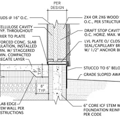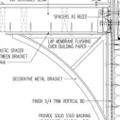Finishing a finished basement
We purchased a brick veneered ranch home in the St Louis area about a year ago. The home is about 44 years old. The brick is in very good condition, but doesn’t have weep holes at the bottom. In several areas that I can check there is an air gap between the brick and sheathing of the 2 x 4 framed wall of the house. This gap appears to be 3/4 to 1 inch. Currently the basement is finished except for 2 utility rooms. The finished areas have 1/2 inch drywall over 1 x 3 or 2 x 2 furring strips attached to the foundation wall. After reading, All about basement insulation, How to insulate a basement, Retrofitting basement insulation and other articles it leaves me with several questions.
1. Is the insulation approach the same for a brick veneer house as a frame?
Foam in rim joist, foam to foundation, 2 x 4 wall…
2. And in my case the bigger question is does this justify the cost, time and effort of gutting a previously finished basement to add proper insulation and refinish?
GBA Detail Library
A collection of one thousand construction details organized by climate and house part









Replies
Mark,
Q. "Is the insulation approach the same for a brick veneer house as a frame?"
A. Assuming you are talking about a basement rather than an above-grade wall, the answer is usually yes. But you many have some misconceptions. To clarify:
1. A brick veneer house is a wood-framed house. The 2x4 or 2x6 studs are the structural walls. The brick veneer is just a type of siding.
2. Foundations vary. Your house may have a poured-concrete foundation, a CMU (concrete block) foundation, or even a brick foundation (although brick foundations are rare). It would be highly unlikely for a 44-year-old house to have a stone foundation, although anything is possible. Note that the foundation type has nothing to do with cladding -- so a brick veneer house can have almost any kind of foundation.
Q. "Does this [presumably, the energy savings] justify the cost, time and effort of gutting a previously finished basement to add proper insulation and refinish?"
A. Assuming I have understood your question correctly -- and "this" means energy savings -- the answer is, "Probably not." Proper insulation would certainly improve comfort, however, and you might want to pursue the work for that reason alone.
If there is a lot of above-grade exposed foundation in that basement there can be an eventual payoff on energy costs too (think decades, not years), but a lot depends on the quality and expense of the finish. Paint on wallboard is cheap, crown molding chair-rail and wainscot can add up fast.
Martin and Dana, thanks for the information. Martin your analysis is correct, a standard 2 x 4 framed house with brick veneer. Dana, 3 sides of the basement below grade with standard exposure at the top for grading. The fourth side is a walk out with standard framed wall and insulation with the brick veneer.